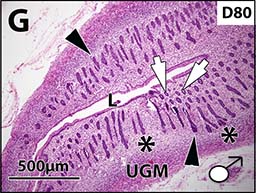Paper accepted: FOXA1 and SOX9 expression in the developing wallaby reproductive system
Just accepted in Sexual Development (10 June 2015):
FOXA1 and SOX9 expression in the developing urogenital sinus of the
tammar wallaby (Macropus eugenii)
by Melissa Gamat, Keng Chew, Geoff Shaw & Marilyn Renfree.

The mammalian prostate is a compact structure in humans but multi-lobed in mice. In humans and mice, FOXA1 and SOX9 play pivotal roles in prostate morphogenesis but few other species have been examined. We examined FOXA1 and SOX9 in the marsupial tammar wallaby, Macropus eugenii which has a segmented prostate more similar to human than to mouse. In males, prostatic budding in the urogenital epithelium (UGE) was initiated by day 24 postpartum (pp) but in the female the UGE remained smooth and had begun forming the marsupial vaginal structures. FOXA1 was up-regulated in the male urogenital sinus (UGS) by day 51 pp, whilst in the female UGS FOXA1 remained basal. FOXA1 was localised in the UGE in both sexes between day 20-80 pp. SOX9 was up-regulated in the male UGS at day 21-30 pp and remained high until day 51-60 pp. SOX9 protein was localised in the distal tips of prostatic buds which were highly proliferative. The sustained up-regulation of the transcription factors SOX9 and FOXA1 after the initial peak and fall of androgen levels suggest that in the tammar, as in other mammals, these factors are required to sustain prostate differentiation, development and proliferation as androgen levels return to basal levels.
Update: The paper is now published and indexed in PUBMED at http://www.ncbi.nlm.nih.gov/pubmed/?term=26406875 and the full citation is:
Gamat, M., Chew, K. Y., Shaw, G. and Renfree, M. B. (2015) FOXA1 and SOX9 Expression in the Developing Urogenital Sinus of the Tammar Wallaby (Macropus eugenii). Sex Dev 9: 216-228